What is BNCT?
What is BNCT?
Proposal of BNCT
It was American physicist G.L. Locher who proposed the idea of using neutron capture reactions, in which a 4He nucleus (alpha particle) and 7Li nucleus are emitted when 10B reacts with thermal neutrons, to destroy cancer cells in cancer treatment, four years after the discovery of the neutron in 1936. Thermal neutrons are captured by a variety of nuclei, but the probability of capture by a 10B (expressed in terms of the capture cross-sectional area in cm-2) is much higher than that of capture by the atoms that constitute human tissue since its cross-section is about 2,000 times larger than that of nitrogen (14N). Furthermore, the track ranges of the two emitted particles are extremely short and do not exceed the diameter of a typical cell. Based on these facts, if there were a 10B-compound that accumulates at sufficient concentrations with a high level of selectivity for cancer cells and tissue, then it would be possible to selectively destroy cancer cells and tissue by irradiating the cancerousregion with neutrons after administerinßg that compound. However, while the probability of this reaction is close to 2,000 times higher than that of the reaction with nitrogen, the extremely high density of nitrogen atoms in tissue makes it necessary for the boron to accumulate in the cancers at levels on the order of several mM.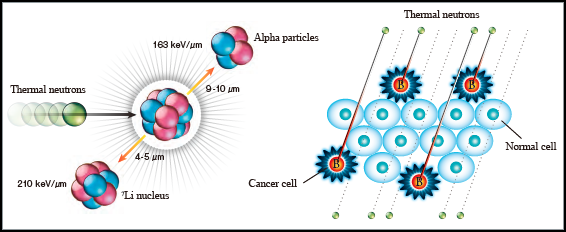
Characteristics and role of BNCT in cancer radiotherapy
Cancer radiotherapy with different high-level selectivity
Recently, high-precision radiotherapy has been praised for the ability to selectively target tumors with pinpoint precision, allowing them to be selectively targeted and irradiated while leaving normal tissue unexposed. This characterization constitutes a misapprehension and is not at all correct. Proton therapy and carbon ion therapy that use the Bragg peak expose normal tissue to large doses of radiation before the particles reach the tumor, as shown in the figure. Moreover, normal tissue (cells) surrounding the tumor and inside the tumor receive the same dose as the tumor itself.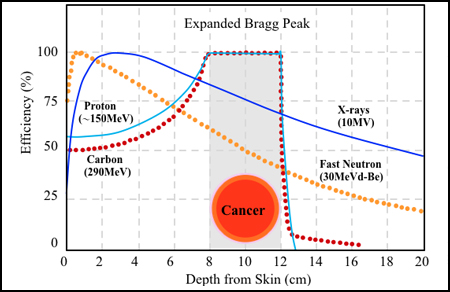
By contrast, BNCT, which allows selective irradiation of cells, differs radically from these approaches. Even normal cells inside the GTV (Gross tumor volume) receive a dose that differs completely from tumor cells. The difference is clear when illustrated with DVH (Dose volume histograms) (see figure): observe that the curves for the normal tissue dose and the tumor (cell) dose do not intersect anywhere. Except for BNCT, there is no treatment in which the DVH curves are completely dissociated from one another. BNCT can administer a dose of radiation to tumors (cells) selectively, making it appropriate to call the technique pinpoint radiotherapy.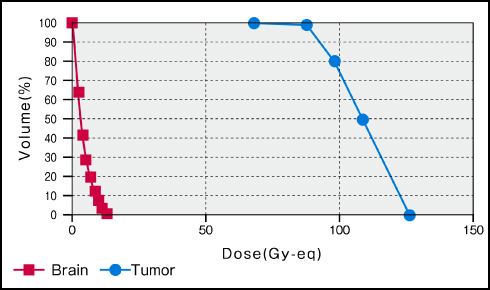
Pioneering and excellent clinical results in Japan
Malignant brain tumors
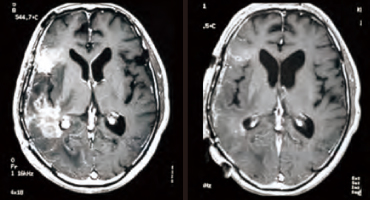 There are high expectations concerning BNCT research targeting treatment of malignant brain tumors, particularly malignant glioma.
There are high expectations concerning BNCT research targeting treatment of malignant brain tumors, particularly malignant glioma.
Since BNCT allows a large radiation dose to be administered at once, there are cases in which the tumor reacts (as evidenced by the degeneration and disappearance of the lesions in MRI ) much more quickly (in about two days), unlike in X-ray therapy. (Photo: A case at Osaka Medical College.)
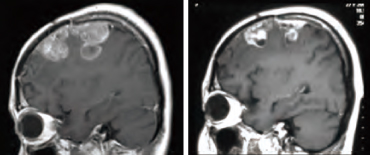 Apart from the above example, there have been malignant meningioma cases in which good tumor response has been achieved. This pathological type of tumor is refractory to X-ray therapy. (Photo: A case at Osaka Medical College.)
Apart from the above example, there have been malignant meningioma cases in which good tumor response has been achieved. This pathological type of tumor is refractory to X-ray therapy. (Photo: A case at Osaka Medical College.)
Head and neck cancers
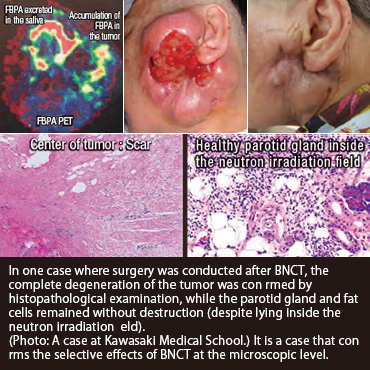 The standard treatment regimen for head and neck cancers combines surgery, X-ray therapy, and chemotherapy. BNCT is expected by radiation oncologists to serve as a technique that makes possible repeated radiation therapy for recurrent patients because re-irradiation by X-rays is not allowed due to the tolerance dose of normal tissue consumed during previous X-ray therapy.
The standard treatment regimen for head and neck cancers combines surgery, X-ray therapy, and chemotherapy. BNCT is expected by radiation oncologists to serve as a technique that makes possible repeated radiation therapy for recurrent patients because re-irradiation by X-rays is not allowed due to the tolerance dose of normal tissue consumed during previous X-ray therapy.
The world's first use of BNCT to treat a head and neck cancer was a case of recurrent cancer of the parotid gland. After two BNCT treatments, the tumor had completely regressed, and the patient’s skin reaction did not reach to the level of dry desquamation. (Photo: A case at Osaka University.) It is not possible with other treatment modalities to avoid damage such as thin and blistered skin while irradiating enough of a control dose to the tumor lying just under the skin. The responses observed in this case showed BNCT’s high degree of tumor selectivity and its superiority.
Malignant pleural mesothelioma (MPM)
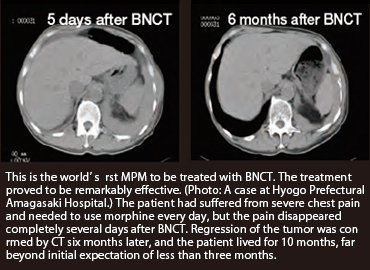 Because the cancer has spread along the pleura in cases of MPM, the tumor presents a complicated, three-dimensional geometry. Consequently, it is impossible to irradiate the tumor with a controlled dose while avoiding the lungs, which are covered with tumors, even using today’s high-precision radiation treatment technologies. Experts hope that treatment techniques such as BNCT to offer a high level of tumor selectivity that will provide superior effectiveness in MPM.(Photo: A case of malignant pleural mesothelioma at Kyoto University Reactor Institute)
Because the cancer has spread along the pleura in cases of MPM, the tumor presents a complicated, three-dimensional geometry. Consequently, it is impossible to irradiate the tumor with a controlled dose while avoiding the lungs, which are covered with tumors, even using today’s high-precision radiation treatment technologies. Experts hope that treatment techniques such as BNCT to offer a high level of tumor selectivity that will provide superior effectiveness in MPM.(Photo: A case of malignant pleural mesothelioma at Kyoto University Reactor Institute)
Malignant melanoma of the skin
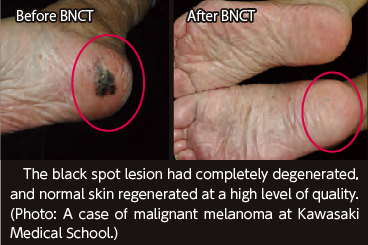 BPA was developed clinically as a boron compound for use with malignant melanoma of the skin, and its tendency to accumulate at high concentrations in melanoma lesions has been confirmed. While surgical removal has proven adequate for treating small lesions, BNCT using BPA is an effective new treatment in cases where the area of removal is large or where removal would lower the patient’s quality of life.
BPA was developed clinically as a boron compound for use with malignant melanoma of the skin, and its tendency to accumulate at high concentrations in melanoma lesions has been confirmed. While surgical removal has proven adequate for treating small lesions, BNCT using BPA is an effective new treatment in cases where the area of removal is large or where removal would lower the patient’s quality of life.
Acknowledgment
"What is BNCT?" section is modified based on brochure from the BNCT Promotion and Research Society. (Furthermore information: http://www.pref.osaka.lg.jp/kikaku/bnct/)